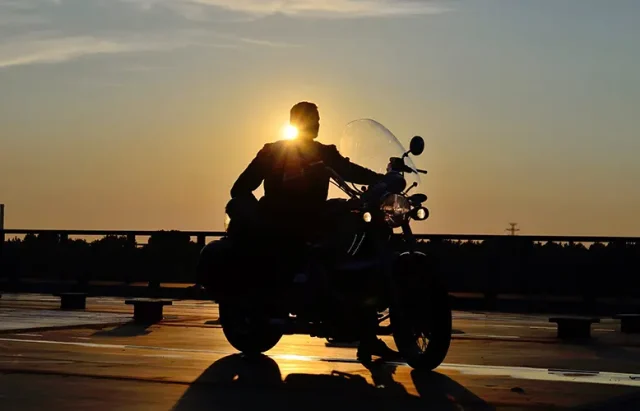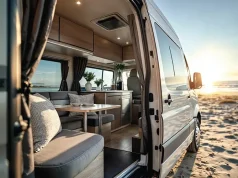
Traveling on a motorcycle solo can be a liberating and thrilling adventure. However, it also means you have to rely entirely on your resources. Ensuring your safety is paramount when you’re the only one responsible for making decisions. Here are essential tips for staying safe while enjoying the solitude of a solo motorcycle journey.
Plan Your Route Wisely
Map It Out
Thoroughly researching your intended path before embarking is essential. While relying on GPS navigation is convenient, it’s equally important to have physical maps on hand as backups, assuring in areas with limited connectivity or electronic mishaps.
Stay Informed
Staying informed about weather forecasts, road closures, or construction zones along your route is imperative, helping you anticipate and navigate through any potential hurdles.
Accommodations
Plan your accommodations and let someone know where you expect to be each night.
Inspect Your Motorcycle Regularly
Conduct a pre-ride check before each leg of your journey.
- Check tire pressure and tread.
- Verify brake functionality.
- Ensure proper lighting.
- Confirm adequate levels of oil, coolant, and brake fluid.
Regularly inspecting these critical elements ensures your motorcycle is in optimal condition, minimizing the risk of unexpected breakdowns during your solo adventure.
Pack Smart
Essentials
Tools for Basic Motorcycle Repairs: Equip yourself with essential tools such as a multi-tool, tire repair kit, spare fuses, duct tape, and a small toolkit for minor fixes or adjustments.
First-Aid Kit: Include basic medical supplies like bandages, antiseptic wipes, pain relievers, adhesive tape, and any personal medications you might need.
Packing Light
Minimalist Approach: Pack only the necessary clothing, toiletries, and items to keep your luggage lightweight and manageable.
Use of Saddlebags and Tank Bags: Opt for luggage options like saddlebags or tank bags that attach securely to your motorcycle. These bags offer space for storage while distributing weight evenly, maintaining the bike’s balance for a safer ride.
Packing smartly not only ensures you have what you need for unforeseen circumstances but also prevents overloading your motorcycle, contributing to a more enjoyable and safer journey.
Stay Connected
Staying connected while on a solo motorcycle journey is crucial for both safety and peace of mind. Always have reliable communication tools at your disposal. Ensure you have a functional cell phone with emergency contacts saved and carry a charger or power bank to keep your phone charged throughout your trip.
Additionally, establish a check-in system with someone back home or a trusted contact. Regularly updating them on your progress using location-sharing apps or scheduled check-in times enhances your safety by ensuring someone is aware of your route and expected schedule.
Dress Appropriately
Dressing appropriately for a solo motorcycle journey is essential for both comfort and safety. Ensure you’re equipped with the right protective gear, starting with a DOT-approved helmet. The Tampa motorcycle accident lawyers from Vanguard Attorneys note that an approved helmet can help protect motorcyclists from sustaining a traumatic brain injury.
Additionally, make sure you have:
- A durable jacket
- Gloves
- Pants
- Boots
Layer your clothing to accommodate fluctuating temperatures during your ride.
Know Your Limits
Ride during the day: Visibility is substantially clearer during daylight hours, reducing the risks associated with reduced visibility in the dark. It’s also easier to navigate and spot potential hazards during the day.
Avoid night riding if possible: Nighttime poses increased challenges due to reduced visibility, fatigue, and the potential presence of wildlife or unexpected road hazards. Minimize the risks by planning your journeys to avoid riding after dark.
Stamina: It’s crucial not to push yourself too hard on a solo motorcycle trip. Determine and stick to realistic travel distances for each day, taking into account rest stops, sightseeing breaks, and any planned stops.
Take frequent breaks: Remember to take regular breaks during your journey. Stopping to stretch, relax, and rest not only helps prevent fatigue but also allows you to appreciate the surroundings and stay refreshed. Stretching your muscles will alleviate any stiffness from long hours of riding.
Handle Emergencies with Confidence
Mechanical Knowledge
Have a basic understanding of your motorcycle’s mechanics in case of a breakdown.
Learn how to change a tire and perform minor repairs.
Emergency Plan
Develop an emergency plan for different scenarios; know what to do if you get stranded.
Keep Personal Safety in Mind
Ensure that crucial documents and valuable possessions are kept securely on your person rather than stored on the motorcycle. Use a secure inner pocket or a travel pouch worn beneath your clothing to safeguard important items like identification, money, and cards.
Maintain heightened awareness of your surroundings, particularly when making stops along your journey. Be cautious and observant, especially in unfamiliar or isolated areas. Park your motorcycle in well-lit and visible spots when taking breaks.
Trust your instincts and intuition. If something seems amiss or feels unsafe, rely on your gut feeling and take action. Whether it’s finding a more secure resting spot or moving away from a situation that raises concerns, prioritize your safety by being attentive to your instincts.
Riding solo can be one of the most rewarding experiences for a biker, as it offers a sense of freedom and self-reliance that’s hard to replicate in a group setting. At the same time, freedom comes with a responsibility to yourself to make smart choices and preparations. By following these safety tips, solo motorcycle travelers can maximize their enjoyment of the trip with the peace of mind that they’re doing what they can to stay safe on their adventures





